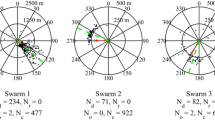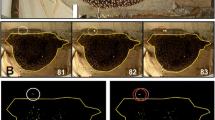Abstract
During reproductive swarming and seasonal migration, a honeybee swarm needs to locate and move to a new, suitable nest site. While the nest-site selection process in cavity-nesting species such as the European honeybee Apis mellifera is very precise with the swarm carefully selecting a single site, open-nesting species, such as Apis florea, lack such precision. These differences in precision in the nest-site selection process are thought to arise from the differing nest-site requirements of open- and cavity-nesting species. While A. florea can nest on almost any tree, A. mellifera is constrained by the scarcity of suitable nest sites. Here we show that imprecision in the nest-site selection process allows swarms to quickly reach a decision when many nest sites are available. In contrast, a very precise nest-site selection process slows down the decision-making process when nest sites are abundant.
Nest-site selection in A. florea appears to be more similar to search-space sampling than to a decision-making process. Bees appear to scout the environment for general areas in which potential nest sites are abundant. Bees involved in searching the environment for suitable nest sites are also involved in guiding the swarm once the decision to depart has been made. Generally A. florea swarms exhibit a lack of consensus in the direction indicated by dancers prior to take-off. Because of this lack of consensus a swarm of A. florea will need to determine its exact direction of travel while in flight. We show that in the absence of directional consensus a swarm of bees can still be guided towards an area containing suitable nest sites provided directional dissent is not too great and nest sites are abundant. However, if the swarm needs to move to a very specific location (a single point in space), directional dissent should be avoided, resulting in a more lengthy decision-making process prior to departure. We further show that the guidance mechanism of bee swarms, so-called ‘streaking’, functions both when directional dissent is present and when it is absent, making it a more general mechanism of group movement than previously thought.
Similar content being viewed by others
References
Ballerini, M., Cabibbo, N., Candelier, R., Cavagna, A., Cisbani, E., Giardina, I., Lecomte, V., Orlandi, A., Parisi, G., Procaccini, A., Viale, M., & Zdravkovic, V. (2008). Interaction ruling animal collective behavior depends on topological rather than metric distance: evidence from a field study. Proceedings of the National Academy of Sciences of the United States of America, 105, 1232–1237.
Beekman, M., Fathke, R., & Seeley, T. (2006). How does an informed minority of scouts guide a honey bee swarm as it flies to its new home? Animal Behaviour, 71(1), 161–171.
Beekman, M., Gloag, R. S., Even, N., Wattanachaiyingcharoen, W., & Oldroyd, B. P. (2008). Dance precision of Apis florea—clues to the evolution of the honeybee dance language? Behavioral Ecology and Sociobiology, 62, 1259–1265.
Camazine, S., Visscher, P. K., Finley, J., & Vetter, R. S. (1999). House-hunting by honey bee swarms: collective decisions and individual behaviors. Insectes Sociaux, 46, 348–360.
Couzin, I. D., Krause, J., Franks, N. R., & Levin, S. A. (2005). Effective leadership and decision-making in animal groups on the move. Nature, 433, 513–516.
Diwold, K., Beekman, M., & Middendorf, M. (2010). Bee nest site selection as an optimization process. In Proceedings of the 12th international conference on the synthesis and simulation of living systems (Alife XII) (pp. 626–633). Cambridge: The MIT Press.
von Frisch, K. (1967). The dance language and orientation of bees. Cambridge: Belknap Press of Harvard University.
Giardina, I. (2008). Collective behavior in animal groups: theoretical models and empirical studies. HFSP Journal, 2, 205–219.
Greene, M. J., & Gordon, D. M. (2007). Interaction rate informs harvester ant task decisions. Behavioral Ecology, 18, 451–455.
Janson, S., Middendorf, M., & Beekman, M. (2005). Honeybee swarms: how do scouts guide a swarm of uninformed bees? Animal Behaviour, 70, 349–358.
Janson, S., Middendorf, M., & Beekman, M. (2006). Searching for a new home—scouting behavior of honeybee swarms. Behavioral Ecology pp. 384–392.
Latty, T., Duncan, M., & Beekman, M. (2009). High bee traffic disrupts transfer of directional information in flying honeybee swarms. Animal Behaviour, 78(1), 117–121.
Lindauer, M. (1955). Schwarmbienen auf Wohnungssuche. Zeitschrift für vergleichende Physiologie, 37, 263–324.
List, C., Elsholtz, C., & Seeley, T. D. (2009). Independence and interdependence in collective decision making: an agent-based model of nest-site choice by honeybee swarms. Philosophical Transactions of the Royal Society of London B, 364, 755–762.
Makinson, J. C., Oldroyd, B. P., Schaerf, T. M., Wattanachaiyingcharoen, W., & Beekman, M. (2011). Moving home: nest-site selection in the red dwarf honeybee (Apis florea). Behavioral Ecology and Sociobiology, doi:10.1007/s00265-010-1095-9.
Mallon, E., Pratt, S., & Franks, N. (2001). Individual and collective decision-making during nest site selection by the ant Leptothorax albipennis. Behavioral Ecology and Sociobiology, 50, 352–359.
Myerscough, M. R. (2003). Dancing for a decision: a matrix model for nest-site choice by honeybees. Proceedings of the Royal Society of London B, 270, 577–582.
Passino, K. M., & Seeley, T. D. (2006). Modeling and analysis of nest-site selection by honeybee swarms: the speed and accuracy trade-off. Behavioral Ecology and Sociobiology, 59, 427–442.
Perdriau, B. S., & Myerscough, M. R. (2007). Making good choices with variable information: a stochastic model for nest-site selection by honeybees. Biology Letters 3, 140–143.
Pratt, S. C., Mallon, E. B., Sumpter, D. J., & Franks, N. R. (2002). Quorum sensing, recruitment, and collective decision-making during colony emigration by the ant Leptothorax albipennis. Behavioral Ecology and Sociobiology, 52, 117–127.
Schaerf, T. M., Myerscough, M. R., Makinson, J. C., & Beekman, M. (2011, submitted). A model for the nest site selection process of Apis florea. Animal Behaviour .
Schneirla, T. C. (1971). The army ants: a study in social organization. San Francisco: W. H. Freeman.
Schultz, K. M., Passino, K. M., & Seeley, T. D. (2008). The mechanism of flight guidance in honeybee swarms: subtle guides or streaker bees? Journal of Experimental Biology, 7, 3287–3295.
Seeley, T. D. (1977). Measurement of nest cavity volume by the honey bee (Apis mellifera). Behavioral Ecology and Sociobiology, 2, 201–227.
Seeley, T. D. (2003). Consensus building during nest-site selection in honey bee swarms: the expiration of dissent. Behavioral Ecology and Sociobiology, 53, 417–424.
Seeley, T. D. (2010). Honeybee democracy. Princeton: Princeton University Press.
Seeley, T. D., & Buhrman, S. C. (1999). Group decision making in swarms of honeybees. Behavioral Ecology and Sociobiology, 45, 19–31.
Seeley, T. D., & Buhrman, S. C. (2001). Nest-site selection in honey bees: how well do swarms implement the “best-of-n” decision rule. Behavioral Ecology and Sociobiology, 49, 416–427.
Seeley, T. D., & Morse, R. A. (1978). Nest site selection by the honey bee, Apis mellifera. Insectes Sociaux, 25, 323–337.
Seeley, T. D., & Visscher, P. K. (2003). Choosing a home: how the scouts in a honey bee swarm perceive the completion of their group decision making. Behavioral Ecology and Sociobiology, 54, 511–520.
Seeley, T. D., & Visscher, P. K. (2004a). Group decision making in nest-site selection by honey bees. Apidologie, 35, 101–116.
Seeley, T. D., & Visscher, P. K. (2004b). Quorum sensing during nest-site selection by honeybee swarms. Behavioral Ecology and Sociobiology, 56, 594–601.
Seeley, T. D., & Visscher, P. K. (2008). Sensory coding of nest-site value in honeybee swarms. Journal of Experimental Biology, 211, 3691–3697.
Seeley, T. D., Morse, R. A. & Visscher, P. K., (1979). The natural history of the flight of honey bee swarms. Psyche, 86, 103–113.
Seeley, T. D., Seeley, R. H., & Akratanakul, P. (1982). Colony defense strategies of the honeybees in Thailand. Ecological Monographs, 54, 43–63.
Sueur, C., Deneubourg, J. L., & Petit, O. (2010). Sequence of quorums during collective decision making in macaques. Behavioral Ecology and Sociobiology, 64, 1875–1885.
Sumpter, D. J. T. (2010). Collective animal behavior. Princeton: Princeton University Press.
Visscher, P. K., & Camazine, S. (1999). Collective decisions and cognition in bees. Nature, 397, 400–400.
Winston, M. L. (1987). The biology of the honey bee. Cambridge: Harvard University Press.
Wongsiri, S., Lekprayoon, C., Thapa, R., Thirakupt, K., Rinderer, T. E., Sylvester, H. A., Oldroyd, B. P., & Booncham, U. (1996). Comparative biology of Apis andreniformis and Apis florea in Thailand. Bee World 77, 23–35.
Author information
Authors and Affiliations
Corresponding author
Additional information
This work was supported by the Human Frontier Science Program, Research Grant “Optimization in natural systems: ants, bees and slime moulds”.
Rights and permissions
About this article
Cite this article
Diwold, K., Schaerf, T.M., Myerscough, M.R. et al. Deciding on the wing: in-flight decision making and search space sampling in the red dwarf honeybee Apis florea . Swarm Intell 5, 121–141 (2011). https://doi.org/10.1007/s11721-011-0054-z
Received:
Accepted:
Published:
Issue Date:
DOI: https://doi.org/10.1007/s11721-011-0054-z




